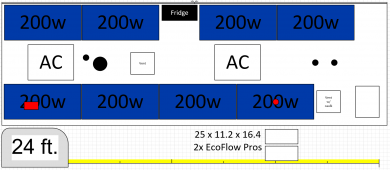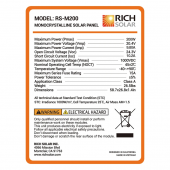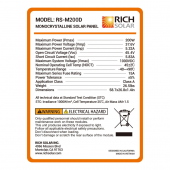In regards to your DIY comment, I total agree. I enjoy having my home automation components, networking devices, etc. built from separate, reliable and understood components for reasons such as troubleshooting, replacement and upgrading.
I have most of the knowledge to build a custom solar/inverter system for my camper but there are a couple of reasons I am wanting to go down the road of this all in one. When all was said and done, I was looking at a system with half the battery power (200 or 300ah SoK batteries) for about $9K after panels, inverters, Honda backup generator, smaller components and accessories. It would have been enough to run 1 AC unit for a small handful of hours and maybe a bit more with solar. And I would have wanted a more expensive 240v inverter for my 50 amp input.
I got in with one of the early bird specials on kick starter. My package has about 600ah of lithium (main unit plus 1x expansion) plus a smart generator for $5K, add about $2K for panels and Unistrut and I am around 7K. It has just about everything I was looking for like a remote panel and app/phone control. Plus, the space the units takes up is less which allows me to install them towards the back of my trailer in a storage area to distribute trailer weight better (most components would have been installed near the tongue otherwise and I am already close to my tongue weight). Also, during winter storage (or any long term storage for that matter), I can have them in the home so I have backup power when needed. It has a 30A RV receptacle on it which most other lithium packs did not which saves me needing to worry about more adapters to plug it into the camper. They added a 5 year warranty (and currently close to a 10 year with stretch goals) so I'm not too worried about a unit crapping out, especially if they are not going to be used full time I will have periods to deal with warranty claims if needed.
Admittedly, it was almost a wash which direction I went and if I wasn't getting almost half off MSRP of what these will sell for after the kick starter it would have been a no brainer to go with piece meal components instead.
As far as the specs of the MPPT, multiple folks have asked ok KS but they have not released any manufacture specific specs on the MPPT device, just 150v/15a/1600w (which was 150v/12a/1200w just a couple of weeks ago, apparently they found a way to upgrade the MPPT portion ahead of their initial release).
I was looking at 8 panels only because the roof space I had would fit them evenly and look more consistent up there and that would meet the 1600w max of the MPPT. I was going to install the Unistrut to hold 8 either way.

Reading your statement about getting closer to 20A rather than 150v is understood. A lower voltage to the MPPT while raising the amps (especially when I had about 5 amps left to begin with) makes sense to me. I already have a run of DC 10AWG wire from the roof with MC4 connectors pre-installed.
So my main take away here is (and with this particular unknown MPPT in mind), an MPPT is designed to limit the amps (in my case 15a) from the panels but not usually voltage. And getting closer to an MPPTs max voltage will put more wear and tear on it as apposed to getting closer to its max amps. So I should stick with 12v panels in 4S2P for ~80v/20a rather than 24v panels in 4S2P for ~150v/10a. Is this an accurate take away?
You stated that the higher amps makes the heat so I would assume that a higher voltage and lower amps would make less heat on an MPPT, no?









